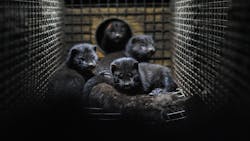Human cases of SARS-CoV-2 mink-associated variant strain in Denmark
Since June 2020, 214 human cases of COVID-19 have been identified in Denmark with SARS-CoV-2 variants associated with farmed minks, including 12 cases with a unique variant, reported on November, stated the World Health Organization (WHO).
All 12 cases were identified in September 2020 in North Jutland, Denmark. The cases ranged in age from seven to 79 years, and eight had a link to the mink farming industry and four cases were from the local community. Initial observations suggest that the clinical presentation, severity and transmission among those infected are similar to that of other circulating SARS-CoV-2 viruses. However, this variant, referred to as the "cluster 5" variant, had a combination of mutations, or changes that have not been previously observed.
The implications of the identified changes in this variant are not yet well understood. Preliminary findings indicate that this particular mink-associated variant identified in both minks and the 12 human cases has moderately decreased sensitivity to neutralizing antibodies. Further scientific and laboratory-based studies are required to verify preliminary findings reported and to understand any potential implications of this finding in terms of diagnostics, therapeutics and vaccines in development. In the meantime, actions are being taken by Danish authorities to limit the further spread of this variant of the virus among mink and human populations.
SARS-CoV-2, the virus which causes COVID-19, was first identified in humans in December 2019. As of 6 November, it has affected more than 48 million people causing over 1.2 million deaths worldwide. Although the virus is believed to be ancestrally linked to bats, the virus origin and intermediate host(s) of SARS-CoV-2 have not yet been identified.
Available evidence suggests that the virus is predominantly transmitted between people through respiratory droplets and close contact, but there are also examples of transmission between humans and animals. Several animals that have been in contact with infected humans, such as minks, dogs, domestic cats, lions and tigers, have tested positive for SARS-CoV-2.
Minks were infected following exposure from infected humans. Minks can act as a reservoir of SARS-CoV-2, passing the virus between them, and pose a risk for virus spill-over from mink to humans. People can then transmit this virus within the human population. Additionally, spill-back (human to mink transmission) can occur. It remains a concern when any animal virus spills in to the human population, or when an animal population could contribute to amplifying and spreading a virus affecting humans. As viruses move between human and animal populations, genetic modifications in the virus can occur. These changes can be identified through whole genome sequencing, and when found, experiments can study the possible implications of these changes on the disease in humans.
To date, six countries, namely Denmark, the Netherlands, Spain, Sweden, Italy and the United States of America have reported SARS-CoV-2 in farmed minks to the World Organization for Animal Health (OIE).
The recent findings reported by the Danish Public Health Authority (Statens Serum Institut) in Denmark related to the novel variant of SARS-CoV-2 identified in humans need to be confirmed and further evaluated to better understand any potential implications in terms of transmission, clinical presentation, diagnostics, therapeutics and vaccine development.
WHO advises all countries to enhance surveillance for COVID-19 at the animal-human interface where susceptible animal reservoirs are identified, including mink farms. WHO also reminds countries to strengthen farming biosafety and biosecurity measures around known animal reservoirs in order to limit the risk of zoonotic events associated with SARS-CoV-2. This includes infection prevention and control measures for animal workers, farm visitors and those who may be involved in animal husbandry or culling.
